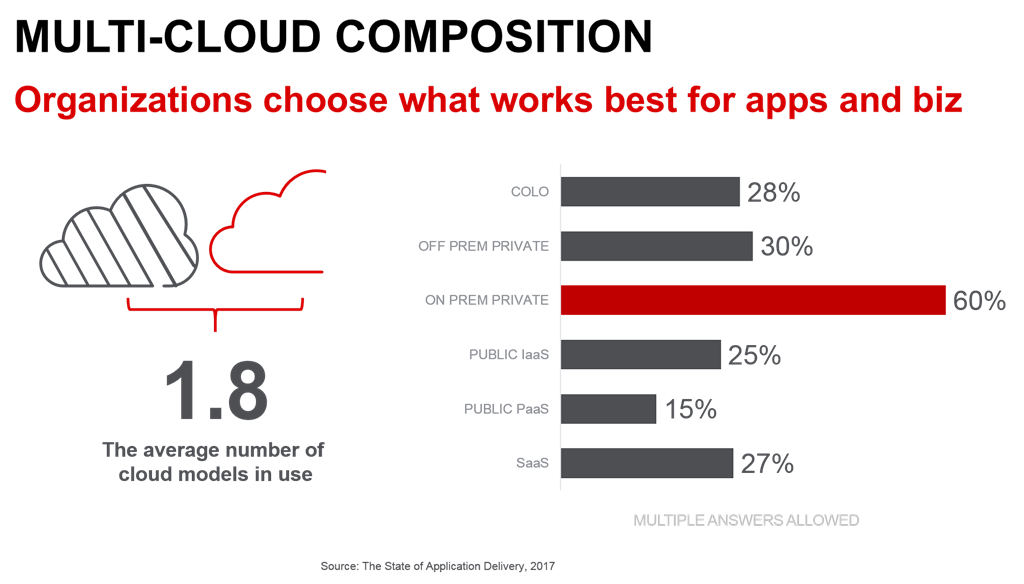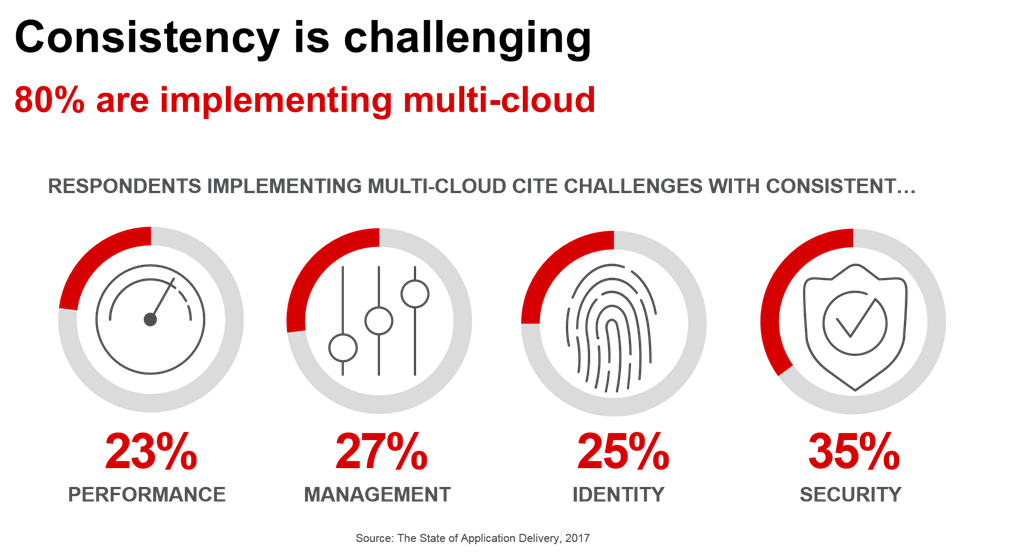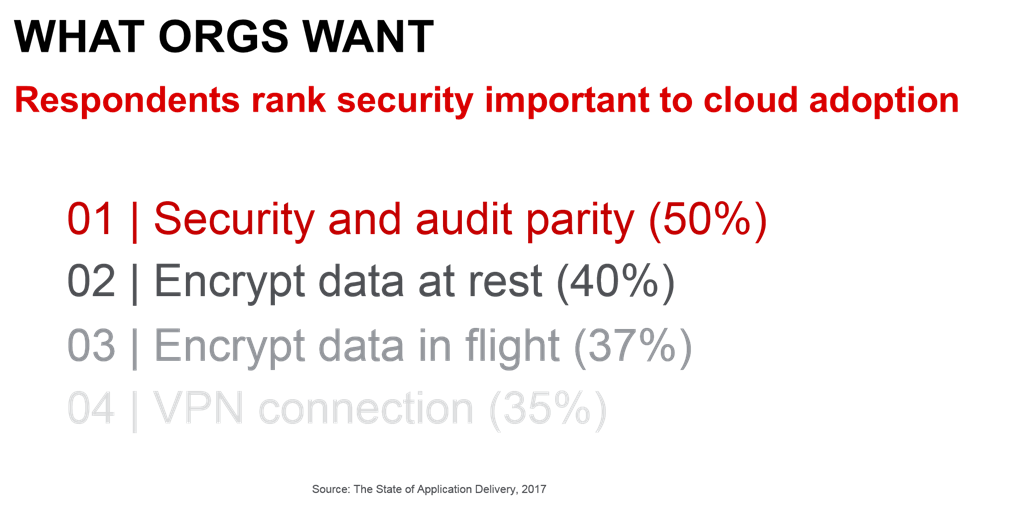2017 年のapplication配信の状況: 曇りのチャレンジ
クラウド コンピューティングは、テクノロジー業界を引き続き支配しています。 それは、考え得るほぼすべての技術的およびビジネス上の問題に対する答えです。 より早く市場に参入する必要がありますか? クラウドを採用しましょう! ビジネスの成長を実現するために規模を拡大する必要がありますか? クラウドを採用しましょう! 変化する市場に合わせてより迅速に方向転換する必要がありますか? クラウドを採用しますか? より健康な髪を手に入れたいですか? クラウドを採用しましょう!
そうですね、最後のものはそうではないかもしれませんが、現実には、クラウドがビジネスと IT があらゆるビジネス課題に対応するのにどのように役立つかについて、私たちはほとんど聞き及んでいます。 クラウド コンピューティングがデジタル トランスフォーメーションの取り組みを支援する能力を持っていることは確かですが、その取り組みを先導してきた人々は課題に直面しています。 2017 年のapplication配信の現状レポートでは、さまざまな脆弱性が明らかになったほか、IT の暗い片隅に潜んでいて、醜い顔をのぞかせるのを待っている脆弱性も明らかになりました。

01 | クラウドは「これらすべて」
これは驚くべきことではありませんが、組織は「クラウド」コンピューティングの定義と使用に関してははるかに寛容です。 私たちは 6 つの異なるクラウド コンピューティング モデルを提示し、回答者がそのすべてを使用していることがわかりました。 圧倒的にプライベート (オンプレミス) クラウドが選択されたモデルでしたが、その他のプライベート (およびパブリック) モデルも確かによく見られました。 平均して、組織は 1.8 種類の異なるクラウド モデルを採用していました。 これは使用されているクラウド プロバイダーの数ではなく、そのモデルのみであることに注意してください。 ほとんどの組織が多数の SaaSapplicationsを使用していることはわかっていますが、それは数あるモデルの 1 つにすぎません。
わずか大多数 (55%) が 1 つのモデルのみを使用している一方で、36% が 2 ~ 3 つの異なるモデルを採用しており、2,100 人を超える回答者のうち 10% が組織内で 4 つ以上の異なるクラウド モデルを使用していました。
明らかに、これはマルチクラウドの世界であり、クラウドへの取り組みを強化する組織が増えるにつれて、組織が使用するモデルの多様性が今後も増加していくでしょう。 しかし、クラウドは使用の面で「すべて」を網羅するようになっているため、組織は異なる環境間で一貫性を維持するという課題に直面しています。 運営上の不和が蔓延している。
02 | 一貫性のあるクラウド
組織が直面している課題について尋ねたところ、「一貫性」という一般的なテーマが最も多く挙げられました。 ある人にとってはapplicationパフォーマンスの一貫性であり、他の人にとってはセキュリティ ポリシーでした。 マルチクラウド環境で運用している回答者の 4 人に 1 人にとって、アイデンティティ管理も依然として課題となっています。 そして、ほぼ同じ数の人々 (27%) が、マルチクラウドの管理に伴う運用上の不和を抑えるという問題に直面しています。

これら 4 つの課題の中で、一貫して最も重要だったのはセキュリティでした。 これは 10 年前の一般的なセキュリティに関する叫びではなく、問題はクラウドのセキュリティが不十分なのではなく、一貫したセキュリティを提供できないことであると認識している、より成熟した経験豊富な導入者の叫びです。
この不一致は、マルチクラウド環境全体にわたるセキュリティ サービスの不一致から生じます。 セキュリティ サービスはクラウド プロバイダーやマーケットプレイスから簡単に入手できるかもしれませんが、ポリシーの実装はオンプレミス サービスとは異なるため、導入者がそれらのポリシーの有効性について同等性と信頼を得ることは困難です。
この課題は回答者の 3 人に 1 人が挙げており、マルチクラウド計画を進める上で導入者が直面する最大の課題となっています。 多くの組織では情報セキュリティとクラウド コンピューティングの両方の職種が空席のままとなっており、人材不足によってこの課題はさらに困難になっています。
03 | スキル不足
情報セキュリティ人材の不足は広く知られています。 セキュリティ業界にとって深刻な問題となっているこの問題については、これまで何年もの間、数多くの記事やブログが書かれてきました。 そして、過去 1 年間で状況は改善していないようです。 2016 年に実施した調査では、回答者の 34% が、直面しているセキュリティ上の最大の課題の 1 つとして「スキル不足」を挙げました。 2017年ですか? また、34% がスキル不足が依然として大きな課題であると回答しています。
これに、すぐに利用できる専門知識の不足がマルチクラウドの取り組みにおける大きな障害であると答えた 29% を加えると、これほど多くの組織がプライベートなオンプレミス クラウドの導入に時間と資金を集中させている理由がわかるかもしれません。
クラウド内のこれら 2 つの穴を埋めることは、特にセキュリティに関しては重要です。 組織はクラウド コンピューティングの利用において成熟しているだけでなく、クラウド導入に関する特定のセキュリティ ニーズに関する明確な一連の要件も策定しています。
04 | セキュリティの知識

今日では、パブリック クラウド環境の本質的なセキュリティについて心配する人は誰もいません。 組織は長い間これらの懸念を無視してきましたが、今日ではそのニーズと要件はより具体的になり、ネットワークからapplicationsまですべてを網羅するよく考えられた戦略を明確に示しています。
それでも、回答者がクラウド導入に重要であると第一に挙げるセキュリティ「機能」は、セキュリティ機能ではなく、一貫性です。 オンプレミスのサービスおよびポリシーとのセキュリティと監査の同等性がリストの 1 位にランクされました。 保存中のデータ(40%)と転送中のデータ(37%)の暗号化は、今年の調査では2位と3位に下がりました。
ここで少し立ち止まって、クラウド導入には転送中のデータの暗号化が重要だと答えた回答者の 11% が、あらゆる場所に SSL を実装する予定はなかったことに注意する必要があります。 これは、彼らが「一部」で SSL を実装していないと言っているわけではありませんが、クラウド導入にとって SSL が重要であると宣言しているにもかかわらず、そのアイデアに「全面的に」取り組んでいなかったのは興味深いことです。
また、セキュリティが「アプリを展開する際に絶対に必要」な項目のリストのトップに躍り出たことも興味深い点です。 3 年以上にわたり、セキュリティがトップの座に上り詰める様子を見てきましたが、他のアプリ サービス カテゴリ (パフォーマンス、ID、可用性、モビリティ) がすぐにその座を奪うことは難しいのではないかと考えています。
クラウドはなくなることはなく、マルチクラウドは間違いなく今日のほとんどの組織の目標です。 残っているのはそこに至るまでの道のりであり、その途中にはいくつかの障害があり、完全なマルチクラウドの世界への移行を妨げるものではありませんが、その進展を妨げています。
SlideShare のスライド形式でデータを自由に閲覧できます。
